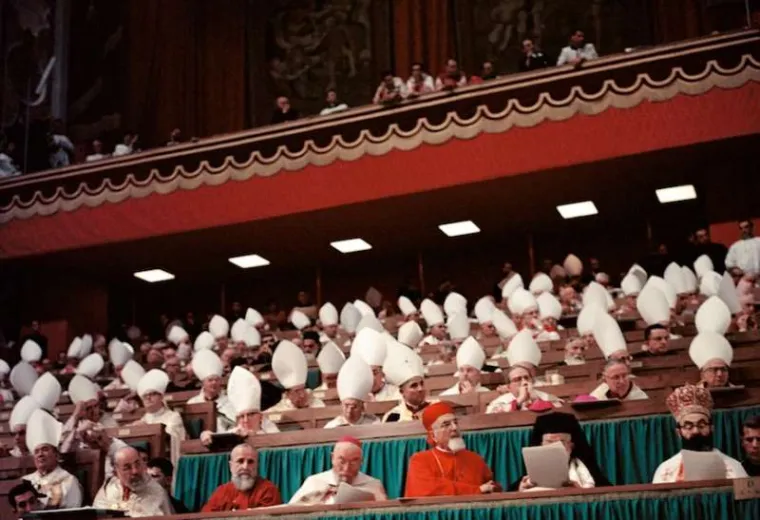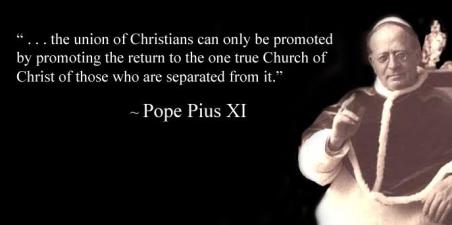

Vatican II not sole controversial council, Catholic theologian says
.-
Amid recent controversy over Vatican II, a theologian said that ecumenical councils have a history of provoking conflict, but their expression and explanation of the Catholic faith is protected by the Holy Spirit.
Lionel. True but other Councils did not use a false premise and inference to change doctrine and theology.The Council Fathers at Vatican Council II (Cushingism, Rahner, Ratzinger etc) did this.
________________________
“The Holy Spirit can't be inconsistent with Himself,” Notre Dame theologian John Cavadini told CNA, but “wrongly interpreted, the statements of an ecumenical council may be inconsistent with previous teaching.”
Lionel : The Holy Spirit will not use a false premise to create a rupture with other Councils on traditional exclusive salvation in the Catholic Church.
________________________
Cavadini was appointed in 2009 by Pope Benedict XVI to serve on the Church’s International Theological Commission, and specializes in the intellectual history of Christianity.
Lionel: In two papers of the International Theological Commission a false premise was used to reject exclusive salvation. This is deceptive. It is unethical. The correction is still not being made.
__________________________
The theologian said Church documents sometimes need clarification, but saying so is not the same as claiming, as some recent critics have, that an ecumenical council might teach or contain errors about the Catholic faith.
The Second Vatican Council was an authoritative meeting of the Catholic Church’s bishops, called an ecumenical council, held in Rome from 1962 to 1965. There have been 21 ecumenical councils in the Church’s history, at which, according to the Catechism of the Catholic Church, “the college of bishops exercises power over the universal Church in a solemn manner.”
Vatican II has been the subject of disagreement since it began.
The council was convened to articulate teachings of the Catholic faith in a matter that might be understood in modernity, to grapple with the Church’s relationship to the secular world, and to address some theological and pastoral questions that had arisen in the decades before it.
Lionel: It used a false premise to make the dogma EENS obsolete. It was the same with the Syllabus of Errors and other Magisterial teachings of the past. Obviously if a false premise is used there will be a false and non traditional conclusion.This cannot be considered Magisterial.
_______________________
Since the conclusion of the Second Vatican Council, it has become a decades-long theological project of the Church’s bishops to interpret and understand the fullness of its vision, in a manner consistent with the doctrinal teachings of the Church. That project has led to numerous theological and pastoral initiatives, and also to division.
Lionel: With the false premise and inference a division is created with the popes and Magisterium of the past.This is schism. The Council is being interpreted in a schismatic way.
There is a choice. The division can be prevented. The false premise can be avoided.
______________________
Some Catholics, including some bishops who attended the Council, felt that attempts to “modernize” the Church’s language or catechesis could lead to equivocation on important issues, or a less precise and direct expression of Catholic doctrine and worship.
Some critics of Vatican II have said that documents produced by the council contain errors, others say they need clarification, while many others have criticized the application of the council in the decades following it, while defending the documents themselves. In some cases, those debates have led to official ruptures in the Church.
In recent months debate over the council itself has become more public, and more acute.
In a June interview, and in other recent letters, Archbishop Carlo Viganò, a former papal representative to the United States, offered a set of criticisms against the Second Vatican Council that attracted considerable attention among some scholars and Catholics, especially because of their source: a former high-ranking Vatican official who had been appointed to positions by Pope St. John Paul and Pope Benedict XVI, both supporters of the Second Vatican Council.
Lionel: Archbishop Carlo Vigano and the Lefebvrists also interpret VC2 with the false premise and then reject the non traditional conclusion. They use the same New Theology as the liberals to interpret the Council and then reject the expected non traditional conclusion, which the liberals welcome.
_____________________
Viganò claimed that at the Second Vatican Council, “hostile forces” caused “the abdication of the Catholic Church” through a “sensational deception.”
“The errors of the post-conciliar period were contained in nuce in the Conciliar Acts,” the archbishop added, accusing the council, and not just its aftermath, of overt error.
Viganò has suggested that the Second Vatican Council catalyzed a massive, but unseen, schism in the Church, ushering in a false Church alongside the true Church.
Lionel: Only with the false premise could a false church be created within the Catholic Church.
________________________
Last month, some Catholics, including priests, media personalities, and some scholars, signed a letter praising Vigano’s engagement on the topic, and claiming that “Whether or not Vatican II can be reconciled with Tradition is the question to be debated, not a posited premise blindly to be followed even if it turns out to be contrary to reason. The continuity of Vatican II with Tradition is a hypothesis to be tested and debated, not an incontrovertible fact.”
Lionel: These were mostly Lefebvrists who interpret Vatican Council II with the false premise and so are politically correct with the Left and the Vatican.
______________________
In response to Viganò, Cavadini wrote in July that he sympathizes with Catholic frustrations “regarding the evident confusion in the Church today, the attenuation of Eucharistic faith, the banality of much of what claims to be the Council’s inheritance liturgically, etc.”
“Yet, is it fair to blame the Council, rejecting it as riddled with error? But would this not mean the Holy Spirit allowed the Church to lapse into prodigious error and further allowed five Popes to teach it enthusiastically for over 50 years?” Cavadini asked.
Lionel: The Holy Spirit did not teach error. This is human error. The popes could not have corrected it, if they were aware of it, for political reasons.
Pope Francis issues encyclicals interpreting Vatican Council II with the same false premise.
___________________________
“Further, did the Second Vatican Council really produce no good worth mentioning? Viganò mentions none. True, its liturgical reforms were commandeered by banality in the United States. For example, there is the introduction of hymns with no aesthetic merit but containing doctrinal errors especially regarding the Eucharist, hymns that de-catechized the very Catholics who faithfully attend Sunday Mass,” he wrote, while noting that he had experienced beautiful liturgies in African nations that were the fruit of the Second Vatican Council.
Speaking of one such Mass in Nigeria, Cavadini wrote, that “when, after Communion, the whole assembly recited in unison three times, ‘O Sacrament Most Holy, O Sacrament Divine, all praise and all thanksgiving be every moment Thine,’ it seemed that the Holy Spirit was making the deepest possible appeal to our hearts, reaching into our souls, helping us to ‘pray as we ought.’”
The theologian also praised the universal call to holiness contained in Lumen gentium, Vatican II’s document on the Church. The council emphasized that sanctity, or closeness to God, is not only the domain of priests and religious, but of all people.
“It is something which seemed so sublime to me when I first read it at age 19 that the desire to live up to it has never worn off even now,” he wrote.
Cavadini catalogued other aspects of Vatican II he said were important theological or pastoral pronouncements. He said claims that documents of Vatican II planted the “seeds” of theological error do not stand up to scrutiny.
“Is Vatican II a bad seed? Or, is the seed in question rather the lopsided choice of theologians to develop one strand of conciliar teaching at the expense of others? Not to mention pastors who have so prioritized the true good of making Christian teaching accessible and intelligible to modern people that they downplay its uniqueness as embarrassingly outmoded?” he asked.
In comments to CNA, Cavadini emphasized that other councils have been misinterpreted and controversial. His essay noted that after some councils, like the Council of Chalcedon, controversies continued for centuries.
“That a statement would need further interpretation is not a unique feature of this council,” Cavadini said.
Lionel: The liberals and Lefebvrists do not deny that a false premise was used to interpret the Letter of the Holy Office 1949 to the Archbishop of Boston relative to Fr. Leonard Feeney.They do not deny that the same false premise was used at Vatican Council II.
Without this error there is nothing in the Council to contradict EENS according to the missionaries of the 16th century.Since LG 8, LG 14, LG 16, UR 3, NA 2, GS 22 etc would refer to only hypothetical and theoretical cases in 2020.
The Lefebvrists and liberals do not want to discuss this point since then they would have to affirm Feeneyite EENS.This would be EENS with the baptism of desire, baptism of blood and invincible ignorance, being only hypothetical cases.They would not be objective exceptions to there being exclusive salvation in the Catholic Church.
Archbishop Vigano also wants to avoid this issue and so have to admit that Archbishop Lefebvre made an objective error on Vatican Council II.
____________________
The theologian raised an example from the Council of Nicea, which took place in the summer of 325. The council, in a discussion about the Trinity, declared that the Son is consubstantial, or homoousios, with the Father.
“There was a widespread reaction against the word,” Cavadini told CNA, by bishops and theologians who equated it with the third-century heresy of Sabellianism, which had been condemned by the Church’s magisterium.
“It was only when the use of the word hupostasis or persona was clarified and distinguished from ousia or ‘substance’ that the ambiguity was clarified. But -- to emphasize -- this was not an error in the teaching itself, far from it! Yet the very act of making a statement sets up a new situation, which often does require further interpretation.”
When Nicea used the word homoousios, “it was taking up a tainted word,” the theologian said.
“Wouldn’t our critics of Vatican II have cried foul? And error? They just don’t remember that even this most famous of councils was bold enough to risk using a tainted word in a new sense with new intent.”
Lionel: This cannot be compared with the interpretations of the Council when what is invisible is assumed to be visible and then the conclusion is considered a development of doctrine. This is an objective error of the popes.
A false premise and inference is used, a new salvation doctrine is created and this considered an acceptable magisterial development.
______________________
He added that amid efforts to interpret a document, official clarification of unclear language is sometimes important.
On matters of faith “an ecumencial council is preserved from error” he added, “but this does not mean that everything was expressed as well as it could have been or could be, for the Holy Spirit doesn't guarantee that, but simply that the Church, in her authoritative teaching, is preserved from outright statements of error.”
Lionel: There are out right statements of error when Vatican Council II is interpreted with the false premise.
_______________________________
Cavadini urged that Catholics, and especially Church leaders, read seriously the documents of Vatican II, and work to incorporate them in their understanding of the Church.
The recent controversy, he wrote, and Viganò’s letter, have “at least had the virtue of forcing me to emerge from complacency in accepting half-measures in the reception of the Council. Perhaps others will find themselves with me in the same boat as well.”
Lionel: Archbishop Carlo Vigano and the Lefebvrists are politically correct with the Left and Pope Francis. They do not want to affirm Feeneyite EENS by interpreting Vatican Council II without the false premise. -Lionel Andrades
https://www.catholicnewsagency.com/news/vatican-ii-not-sole-controversial-ecumenical-council-catholic-theologian-says-64458






























